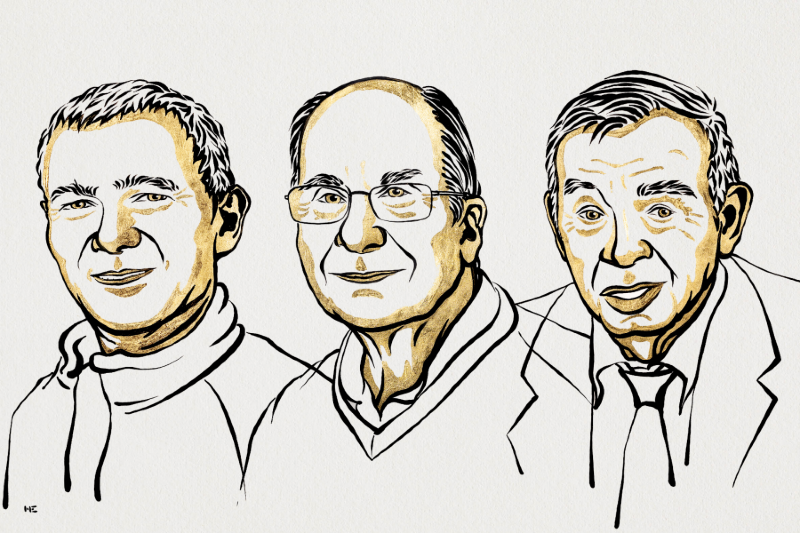Three scientists were named joint winners of the 2023 Nobel Prize in Chemistry for their innovation in the field of nanotechnology. Moungi Bawendi, PhD, Massachusetts Institute of Technology, Louis Brus, PhD, Columbia University, and Alexei Ekimov, PhD, former chief scientist at Nanocrystals Technology, shared this year’s prize for the discovery and synthesis of tiny nanoparticles called quantum dots that are now being used in a range of applications from biology and medicine to consumer electronics.
Quantum dots are tiny nanoparticles whose size determines their “fascinating and unusual properties” including color. It was noted during the announcement that Ekimov and Brus were the first to observe the effects of quantum dots in glass and floating freely in solution, and Bawendi invented a method for making “perfect nanoparticles of very specific size and very high quality,” which has allowed the technology to be used widely including in biochemistry and medicine imaging with more applications on the way.
The discoveries honored by this year’s chemistry award can trace their roots back to the early 1980s when Ekimov first created size-dependent quantum effects in colored glass. A few years after that, Brus proved size-dependent quantum effects in particles in solution.
These discoveries were particularly noteworthy because although physicists knew theoretically that size-dependent quantum effects could appear in nanoparticles, sculpting in nanodimensions was difficult, making it challenging to make quantum dots in reality. Building on work from Herbert Frohlich, a physicist who predicted nanoparticles’ behaviors in 1937, researchers successfully made a nanoparticle using an ultra-high vacuum and temperatures close to absolute zero in the 1970s. However, the complexities of the process made it unlikely that the technology could ever have practical applications. The answer to that question would not come for several more years.
Ekimov studied semiconductors during his doctoral degree and knew about the optical methods used to assess the quality of semiconducting material. After some initial experiments where he used those methods to examine colored glass, he began producing glass tinted with copper chloride. X-rays of the glass he made showed tiny crystals of copper that ranged from 2–30 nanometers. He also discovered that the glass’ light absorption was affected by the size of the particles with the largest particles absorbing light in the same way copper chloride normally does while the smaller ones absorbed bluer light. He published his discovery in 1981 in a Soviet scientific journal that was not accessible to scientists outside the Soviet Union.
Unaware of Ekimov’s work, Brus worked on the problem separately at Bell Laboratories. He was using solar energy to make chemical reactions with particles of cadmium sulfide, in solution. These particles capture and use energy from light to drive reactions. He noticed changes in the particles’ optical properties over time and suspected that this was because they grew bigger. He tested his idea by comparing the optical properties of differently-sized cadmium sulfide particles. Much like Ekimov, he found that larger particles absorbed light at the same wavelength as the compound, cadmium sulfide in this case, while the smaller particles absorbed bluer light. He published his discovery in 1983.
However, the methods that Brus used resulted in unevenly sized particles and unpredictable quality which hindered further development. Then in 1993, the field changed again when Bawendi developed a method of addressing this problem that resulted in high-quality quantum dots, and this paved the way for the technology to finally be used in a variety of potential applications. His efforts began during his postdoctoral training in Brus’ laboratory in 1988. Scientists there were experimenting with various ways of producing well-organized nanocrystals. Bawendi continued working on the problem when he left Brus’ lab for MIT. It was there that he made his breakthrough by injecting the substances that form nanocrystals into a heated solvent. By varying the temperature of the solution, Bawendi’s group was able to grow nanocrystals of a specific size with smooth even surfaces.
Today, quantum dots are used in televisions and LED lamps and also in biomedical applications such as in surgeries to remove tumor tissue. A paper published last year in the International Journal of Nanomedicine discussed several clinical applications of quantum dots in biomedicine for things like cell imaging, photodynamic therapy for treating various solid tumors, and drug delivery vectors. The paper also highlighted various clinical trials involving the use of quantum dots. That list includes trials focused on breast and skin cancer and type I diabetes. In 2019, researchers from MIT and elsewhere published a paper that described a microneedle platform that used quantum dots to deliver vaccines and encode vaccine history directly in the skin.
The winners of this year’s chemistry prize were announced by the Nobel Prize Committee in Stockholm. However, prior to the official announcement, the names of all three scientists were leaked to the Swedish press. At the time of this reporting, it is unclear exactly how the leak occurred and the academy declined to answer questions about the leak during the press conference.


